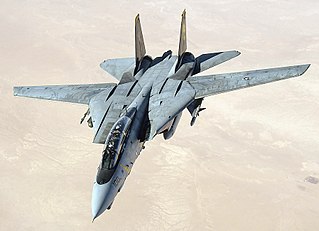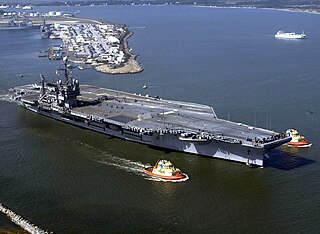
The Grumman F-14 Tomcat is an American supersonic, twin-engine, two-seat, twin-tail, variable-sweep wing fighter aircraft. It was the first such U.S. jet fighter with twin tails. The Tomcat was developed for the United States Navy's Naval Fighter Experimental (VFX) program after the collapse of the F-111B project. The F-14 was the first of the American Teen Series fighters, which were designed incorporating air combat experience against MiG fighters during the Vietnam War.

The 1986 United States bombing of Libya, code-named Operation El Dorado Canyon, comprised air strikes by the United States against Libya on Tuesday, April 15, 1986. The attack was carried out by the U.S. Air Force, U.S. Navy and U.S. Marine Corps via air strikes, in retaliation for the 1986 West Berlin discotheque bombing. There were 40 reported Libyan casualties, and one U.S. plane was shot down. One of the claimed Libyan deaths was of a baby girl, reported to be Muammar Gaddafi's daughter, Hana Gaddafi. However, there were doubts as to whether she was really killed, or whether she really even existed. Military intelligence reports cited Gaddafi fleeing his location and leaving his family members behind when inbound missiles were determined to be targeting his location.

USS John F. Kennedy (CV-67) is the only ship of her class and the last conventionally powered carrier built for the United States Navy. The ship is named after the 35th President of the United States, John F. Kennedy, and is nicknamed "Big John." Kennedy was originally designated a CVA ; however, the designation was changed to CV to denote that the ship was capable of anti-submarine warfare, making her an all-purpose carrier.

USS Saratoga (CV/CVA/CVB-60), was the second of four Forrestal-class supercarriers built for the United States Navy in the 1950s. Saratoga was the sixth U.S. Navy ship, and the second aircraft carrier, to be named for the Battles of Saratoga in the American Revolutionary War.

Gulf of Sirte, or Gulf of Sidra after the port of Sidra, is a body of water in the Mediterranean Sea on the northern coast of Libya. Historically it has been also known as the Great Sirte or Greater Syrtis.

On 4 January 1989, two United States Navy F-14 Tomcats shot down two Soviet manufactured Libyan MiG-23 Floggers which the Americans believed were attempting to engage them, as had happened eight years prior during the Gulf of Sidra incident, in 1981. The engagement took place over the Mediterranean Sea about 40 miles (64 km) north of Tobruk, Libya.

Iran Air Flight 655 was a scheduled passenger flight from Tehran to Dubai, via Bandar Abbas, that was shot down on 3 July 1988 by an SM-2MR surface-to-air missile fired from USS Vincennes, a guided missile cruiser of the United States Navy. The aircraft, an Airbus A300, was destroyed, and all 290 people on board, including 66 children, were killed. The jet was hit while flying over Iran's territorial waters in the Persian Gulf, along the flight's usual route, shortly after departing Bandar Abbas International Airport, the flight's stopover location. Vincennes had entered Iranian territory after one of its helicopters drew warning fire from Iranian speedboats operating within Iranian territorial limits.

Strike Fighter Squadron 211 (VFA-211), nicknamed the "Fighting Checkmates", is an aviation unit of the United States Navy established in 1945. The squadron is based at Naval Air Station Oceana and is equipped with the F/A-18F Super Hornet.

VFA-31 or Strike Fighter Squadron 31 is known as the Tomcatters, callsign "Felix", a United States Navy strike fighter squadron stationed at Naval Air Station Oceana flying the F/A-18E Super Hornet. The Tomcatters are the second oldest Navy Fighter Attack squadron operating today.

Strike Fighter Squadron 213 (VFA-213) Blacklions is an aviation unit of the United States Navy based at Naval Air Station Oceana, Virginia. It was established in 1955 and is currently equipped with the F/A-18F Super Hornet. The squadron is assigned to Carrier Air Wing Eight and uses the radio callsign Lion.

Strike Fighter Squadron 102 (VFA-102) is a United States Navy Strike Fighter squadron based at Marine Corps Air Station Iwakuni. Their call sign is Dback, with the tail code NF, and they fly the F/A-18F Super Hornet.

Strike Fighter Squadron 41 (VFA-41) also known as the "Black Aces", is a United States Navy strike fighter squadron based at Naval Air Station Lemoore, California, flying the F/A-18F Super Hornet. They are attached to Carrier Air Wing 9 (CVW-9). Their radio callsign is "Fast Eagle" and their tailcode is NG.

Fighter Squadron 33 or VF-33 was an aviation unit of the United States Navy. Originally established on 11 October 1948 it was disestablished on 1 October 1993. It was the second US Navy Squadron to be designated VF-33.
The Grumman F-14 Tomcat has served with the United States Navy and the Islamic Republic of Iran Air Force (IRIAF) It operated aboard U.S. aircraft carriers from 1974 to 2006 and remains in service with Iran. In-depth knowledge of its service with Iran is relatively limited.

Strike Fighter Squadron 81 (VFA-81), also known as the "Sunliners", is a United States Navy F/A-18E Super Hornet strike fighter squadron stationed at Naval Air Station Oceana. They are a part of Carrier Air Wing One, their radio callsign is Inferno, and their tail code is AB. Their mission is to conduct prompt and sustained combat operations from the sea. The squadron was originally designated VA-66 on 1 July 1955, was redesignated VF-81 the same day, redesignated VA-81 on 1 July 1959, and finally redesignated VFA-81 on 4 February 1988.

Strike Fighter Squadron 83 (VFA-83), also known as the "Rampagers", are a United States Navy F/A-18E Super Hornet fighter squadron stationed at Naval Air Station Oceana. They are a part of Carrier Air Wing 3, their tailcode is AC and their radio callsign is Ram.
The military history of Libya covers the period from the ancient era to the modern age.
The following lists events that happened during 1981 in Libya.
















